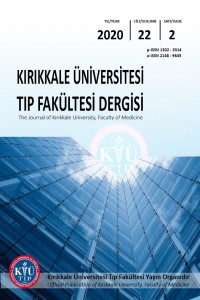Öz
Anahtar Kelimeler
conservative management distal radius fractures closed reduction geriatric fractures
Kaynakça
- 1. Karl JW, Olson PR, Rosenwasser MP. The Epidemiology of Upper Extremity Fractures in the United States, 2009. J Orthop Trauma. 2015;29(8):242-4.
- 2. Padegimas EM, Ilyas AM. Distal radius fractures: emergency department evaluation and management. Orthop Clin North Am. 2015;46(2):259-70.
- 3. Walenkamp MM, Rosenwasser MP, Goslings JC, Schep NW. A multicentre cross-sectional study to examine physicians' ability to rule out a distal radius fracture based on clinical findings. Eur J Trauma Emerg Surg. 2016;42(2):185-90.
- 4. Mauck BM, Swigler CW. Evidence-Based Review of Distal Radius Fractures. Orthop Clin North Am. 2018;49(2):211-22.
- 5. Wei DH, Raizman NM, Bottino CJ, Jobin CM, Strauch RJ, Rosenwasser MP. Unstable distal radial fractures treated with external fixation, a radial column plate, or a volar plate. A prospective randomized trial. J Bone Joint Surg Am. 2009;91(7):1568-77.
- 6. Koval K, Haidukewych GJ, Service B, Zirgibel BJ. Controversies in the management of distal radius fractures. J Am Acad Orthop Surg. 2014;22(9):566-75.
- 7. Chung KC, Shauver MJ, Birkmeyer JD. Trends in the United States in the treatment of distal radial fractures in the elderly. J Bone Joint Surg Am. 2009;91(8):1868-73.
- 8. Diaz-Garcia RJ, Oda T, Shauver MJ, Chung KC. A systematic review of outcomes and complications of treating unstable distal radius fractures in the elderly. J Hand Surg Am. 2011;36(5):824-35.
- 9. Lutz K, Yeoh KM, MacDermid JC, Symonette C, Grewal R. Complications associated with operative versus nonsurgical treatment of distal radius fractures in patients aged 65 years and older. J Hand Surg Am. 2014;39(7):1280-6.
- 10. Egol KA, Walsh M, Romo-Cardoso S, Dorsky S, Paksima N. Distal radial fractures in the elderly: operative compared with nonoperative treatment. J Bone Joint Surg Am. 2010;92(9):1851-7.
- 11. Levin LS, Rozell JC, Pulos N. Distal Radius Fractures in the Elderly. J Am Acad Orthop Surg. 2017;25(3):179-87.
- 12. Murray J, Gross L. Treatment of distal radius fractures. J Am Acad Orthop Surg. 2013;21(8):502-5.
- 13. Perugia D, Guzzini M, Civitenga C, Guidi M, Dominedo C, Fontana D et al. Is it really necessary to restore radial anatomic parameters after distal radius fractures? Injury. 2014;45:21-6.
- 14. Cooney WP. Management of Colles' fractures. J Hand Surg Br. 1989;14(2):137-9.
- 15. Wu YS, Yang J, Xie LZ, Zhang JY, Yu XB, Hu W et al. Factors associated with the decision for operative versus conservative treatment of displaced distal radius fractures in the elderly. ANZ J Surg. 2019;89(10):428-32.
- 16. Kong L, Kou N, Wang Y, Lu J, Tian D, Zhang B. The Necessity of Restoration of Radiologic Parameters by Closed Reduction in Elderly Patients with Distal Radius Fractures. Med Sci Monit. 2019;25:6598-604.
Öz
Anahtar Kelimeler
konservatif tedavi Radius distal uç kırıkları geriatrik kırıklar kapalı redüksiyon
Kaynakça
- 1. Karl JW, Olson PR, Rosenwasser MP. The Epidemiology of Upper Extremity Fractures in the United States, 2009. J Orthop Trauma. 2015;29(8):242-4.
- 2. Padegimas EM, Ilyas AM. Distal radius fractures: emergency department evaluation and management. Orthop Clin North Am. 2015;46(2):259-70.
- 3. Walenkamp MM, Rosenwasser MP, Goslings JC, Schep NW. A multicentre cross-sectional study to examine physicians' ability to rule out a distal radius fracture based on clinical findings. Eur J Trauma Emerg Surg. 2016;42(2):185-90.
- 4. Mauck BM, Swigler CW. Evidence-Based Review of Distal Radius Fractures. Orthop Clin North Am. 2018;49(2):211-22.
- 5. Wei DH, Raizman NM, Bottino CJ, Jobin CM, Strauch RJ, Rosenwasser MP. Unstable distal radial fractures treated with external fixation, a radial column plate, or a volar plate. A prospective randomized trial. J Bone Joint Surg Am. 2009;91(7):1568-77.
- 6. Koval K, Haidukewych GJ, Service B, Zirgibel BJ. Controversies in the management of distal radius fractures. J Am Acad Orthop Surg. 2014;22(9):566-75.
- 7. Chung KC, Shauver MJ, Birkmeyer JD. Trends in the United States in the treatment of distal radial fractures in the elderly. J Bone Joint Surg Am. 2009;91(8):1868-73.
- 8. Diaz-Garcia RJ, Oda T, Shauver MJ, Chung KC. A systematic review of outcomes and complications of treating unstable distal radius fractures in the elderly. J Hand Surg Am. 2011;36(5):824-35.
- 9. Lutz K, Yeoh KM, MacDermid JC, Symonette C, Grewal R. Complications associated with operative versus nonsurgical treatment of distal radius fractures in patients aged 65 years and older. J Hand Surg Am. 2014;39(7):1280-6.
- 10. Egol KA, Walsh M, Romo-Cardoso S, Dorsky S, Paksima N. Distal radial fractures in the elderly: operative compared with nonoperative treatment. J Bone Joint Surg Am. 2010;92(9):1851-7.
- 11. Levin LS, Rozell JC, Pulos N. Distal Radius Fractures in the Elderly. J Am Acad Orthop Surg. 2017;25(3):179-87.
- 12. Murray J, Gross L. Treatment of distal radius fractures. J Am Acad Orthop Surg. 2013;21(8):502-5.
- 13. Perugia D, Guzzini M, Civitenga C, Guidi M, Dominedo C, Fontana D et al. Is it really necessary to restore radial anatomic parameters after distal radius fractures? Injury. 2014;45:21-6.
- 14. Cooney WP. Management of Colles' fractures. J Hand Surg Br. 1989;14(2):137-9.
- 15. Wu YS, Yang J, Xie LZ, Zhang JY, Yu XB, Hu W et al. Factors associated with the decision for operative versus conservative treatment of displaced distal radius fractures in the elderly. ANZ J Surg. 2019;89(10):428-32.
- 16. Kong L, Kou N, Wang Y, Lu J, Tian D, Zhang B. The Necessity of Restoration of Radiologic Parameters by Closed Reduction in Elderly Patients with Distal Radius Fractures. Med Sci Monit. 2019;25:6598-604.
Ayrıntılar
| Birincil Dil | İngilizce |
|---|---|
| Konular | Sağlık Kurumları Yönetimi |
| Bölüm | Makaleler |
| Yazarlar | |
| Yayımlanma Tarihi | 31 Ağustos 2020 |
| Gönderilme Tarihi | 5 Mart 2020 |
| Yayımlandığı Sayı | Yıl 2020 Cilt: 22 Sayı: 2 |
Kaynak Göster
Bu Dergi, Kırıkkale Üniversitesi Tıp Fakültesi Yayınıdır.


